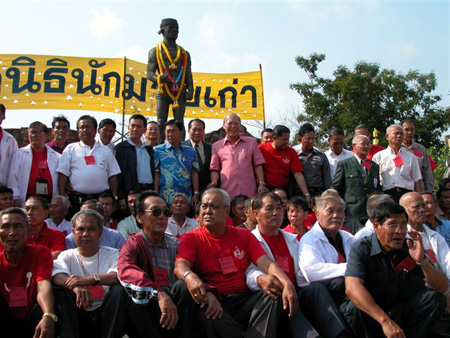The indomitable spirit of Muay Thai
by Marco De Cesaris
The human body, adequately trained
and encouraged by the warrior spirit that pushes it to act without fear,
is comparable to a weapon: that is the credo of the majority of the
Eastern Arts of combat. The legends of the martial traditions of India,
China, Japan, Korea, and of Southeast Asia are full of tales that “brush
up against” the paranormal, tales in which the hero defends against
lines of armed and unarmed adversaries with the help of his limbs and
his courage. Devastating blows executed with the palm of the hand, fingers
as hard as iron that penetrate muscles and bones, heel strikes that
hit the head of the bad guy in question like axes, all of that forms
a part of an ancient tradition transmitted throughout centuries in the
Martial Arts circles of the Far East.
In Muay Thai, the most emblematic figure of these traditions, among
the legends and history, is undoubtedly the founder of all the adept
fighters of this Art, the celebrated warrior Nai Khanom Thom. The history
of his life represents the archetype of the feats of the warrior loyal
to is homeland and to his own Martial Art, who, at the moment of maximum
discouragement and difficulty, is inspired by his fundamental values
in order to get over obstacles apparently impossible to get over, regaining
his own freedom as well as that of his companions, and indirectly, all
of his people.
Taken prisoner by the Burmese, the invaders of his country, captured
in the course of the terrible attack on the ancient capital Ayuddhaya
in 1774, Nai Khanom Thom was taken to prison in Burma (the current Myanmar)
along with many other soldiers. During the fighting tournaments in which
the Burmese made the prisoners engage like gladiators, Thom was noticed
by the Burmese king, Mangra, who very much enjoyed watching him in action,
watching the great combat skill of our hero. Desirous of putting to
the test the effectiveness of the Siamese fighting style that caused
many losses among the Burmese conquerors, King Mangra decided to do
a combat without weapons between the best Thai prisoner and a group
of the best Burmese gladiators in his army. The great power of the way
of fighting utilized by the Thais could not of course be superior to
the skill of the greatest warriors in Burma! There, history and legend
mix: one speaks of an epic, empty-hands combat to the death between
the Thai champion and 10 Burmese warriors (according to other sources,
there were 12 or even 13). What is certain is that the combat style
used by Nai Khanom Thom was very similar to what we today call Muay
Kard Chiek, or fighting with the hands tied in ropes: Thom was accustomed
to using all the resources of his being, as much physical as psychological
in order to defeat his adversaries. The Muay Kard Chiek fighters of
that epoch were compared to starving tigers; any offensive action was
accepted, punches, elbow strikes, kicks, head butts, joint bars, chokes,
throws, even bites and scratches on soft parts… all that formed
a part of what a gladiator of that time used. With that technical baggage,
Nai Khanom Thom confronted the toughest challenge of his career as a
fighter and soldier, fighting not only for his life, but also to save
his companions and to regain freedom.
It is told that the Thai hero managed to defeat the adversaries one
after the other, intelligently utilizing his mobility and speed in combat.
In fact, the Burmese were known for the power of their punches and for
their strength in hand-to-hand combat. For that, Thom used his speed
in the best possible way, striking with kicks, knee strikes and elbow
strikes, executed with savage power; he threw tibias, knees, and elbows
as hard as iron that struck the vital points of his adversaries. The
traditional short, loin cloth pants of the Thais facilitated his agile
movements and actions, allowing him not to fall prey to the attacks
of the Burmese fighters. The legend tells us that, once defeating all
the adversaries, it was the very King Mangra who decided to concede
the freedom of the Thai hero and of his soldiers who were taken prisoners.
It is said that the king observed with admiration the incredible test
carried out by the Siamese fighter and came to affirm that “every
part of the Thai body is poisonous, even without weapons they beat their
enemies.”
The positive effect of Nai Khanom Thom’s feat—apart from
gaining his freedom—was to give confidence back to the Thai people,
who can be beaten down, but who never give up.
Since then, the figure of this great hero is the symbol of the indomitable
spirit of the Thai Martial Art: the true martial artist is one who puts
his sense of honor before self-interest, even though that forces great
sacrifices upon him. Patriotism, the very Martial Art itself, the school
where one has been trained, the Master, the community of fellow practitioners:
these are the values for which Nai Khanom Thom fought and for that his
figure is still current and worthy of great respect.
From centuries ago, March 17th is his day, and in Thailand, as in the
rest of the world, the true Thai boxers honor him, as much today as
they did back then.
